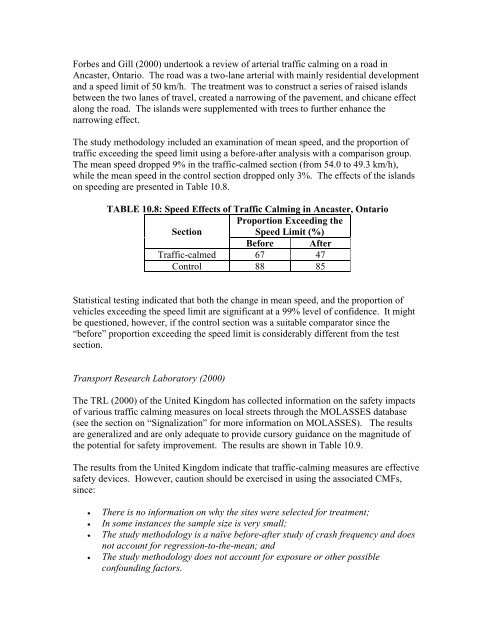Synthesis of Safety for Traffic Operations - Transports Canada
Synthesis of Safety for Traffic Operations - Transports Canada
Synthesis of Safety for Traffic Operations - Transports Canada
Create successful ePaper yourself
Turn your PDF publications into a flip-book with our unique Google optimized e-Paper software.
Forbes and Gill (2000) undertook a review <strong>of</strong> arterial traffic calming on a road in<br />
Ancaster, Ontario. The road was a two-lane arterial with mainly residential development<br />
and a speed limit <strong>of</strong> 50 km/h. The treatment was to construct a series <strong>of</strong> raised islands<br />
between the two lanes <strong>of</strong> travel, created a narrowing <strong>of</strong> the pavement, and chicane effect<br />
along the road. The islands were supplemented with trees to further enhance the<br />
narrowing effect.<br />
The study methodology included an examination <strong>of</strong> mean speed, and the proportion <strong>of</strong><br />
traffic exceeding the speed limit using a be<strong>for</strong>e-after analysis with a comparison group.<br />
The mean speed dropped 9% in the traffic-calmed section (from 54.0 to 49.3 km/h),<br />
while the mean speed in the control section dropped only 3%. The effects <strong>of</strong> the islands<br />
on speeding are presented in Table 10.8.<br />
TABLE 10.8: Speed Effects <strong>of</strong> <strong>Traffic</strong> Calming in Ancaster, Ontario<br />
Proportion Exceeding the<br />
Section<br />
Speed Limit (%)<br />
Be<strong>for</strong>e After<br />
<strong>Traffic</strong>-calmed 67 47<br />
Control 88 85<br />
Statistical testing indicated that both the change in mean speed, and the proportion <strong>of</strong><br />
vehicles exceeding the speed limit are significant at a 99% level <strong>of</strong> confidence. It might<br />
be questioned, however, if the control section was a suitable comparator since the<br />
“be<strong>for</strong>e” proportion exceeding the speed limit is considerably different from the test<br />
section.<br />
Transport Research Laboratory (2000)<br />
The TRL (2000) <strong>of</strong> the United Kingdom has collected in<strong>for</strong>mation on the safety impacts<br />
<strong>of</strong> various traffic calming measures on local streets through the MOLASSES database<br />
(see the section on “Signalization” <strong>for</strong> more in<strong>for</strong>mation on MOLASSES). The results<br />
are generalized and are only adequate to provide cursory guidance on the magnitude <strong>of</strong><br />
the potential <strong>for</strong> safety improvement. The results are shown in Table 10.9.<br />
The results from the United Kingdom indicate that traffic-calming measures are effective<br />
safety devices. However, caution should be exercised in using the associated CMFs,<br />
since:<br />
• There is no in<strong>for</strong>mation on why the sites were selected <strong>for</strong> treatment;<br />
• In some instances the sample size is very small;<br />
• The study methodology is a naïve be<strong>for</strong>e-after study <strong>of</strong> crash frequency and does<br />
not account <strong>for</strong> regression-to-the-mean; and<br />
• The study methodology does not account <strong>for</strong> exposure or other possible<br />
confounding factors.
















